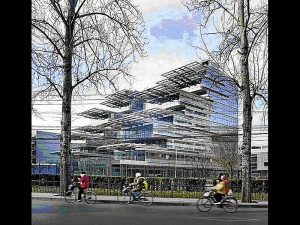
SINO-ITALIAN Ecological and Energy-Efficient Building (SIEEB) at Tsinghua University in Beijing is a showcase of energy efficiency before it was fitted with solar panels. Photo by Daniele Domenicali
MANY PEOPLE are very interested in solar panels and wind turbines. These new technologies deliver clean energy from natural processes that are sustainable with practically unlimited supply.
What’s wrong with renewable energy?
There seems to be much focus on renewable energy and not enough on energy conservation and energy efficiency.
Putting too much emphasis on renewable energy without exhausting less energy consumption is much like installing a powerful booster pump to bring water inside the home when the pipes are old and leaking. What you gain is lost in inefficiency.
It is reported that wind power saves roughly US$38 per ton of carbon dioxide emission eliminated, while solar panels save US$30 per ton CO2 eliminated. On the other hand, replacing incandescent lights with LED lamps saves US$159 per ton CO2, and using energy-efficient appliances saves roughly US$108 per ton CO2 eliminated.
Energy efficiency and conservation measures have much lower payback period and help businesses save money. Before investing huge amounts of money in renewables, governments could look into exhausting less energy consumption projects.
A computer-based environmental control system offers integrated reporting systems in intelligent buildings. This monitors energy and water use to ensure high operational efficiency.
Mechanical systems such as the AC zone control help to control individual room temperature by the use of motorized dampers and thermostats that work independently. This can cut energy use up to 25 percent.
Condensing boilers remove heat from the fuel as it is used in industrial projects. They have 15 percent higher efficiency than traditional boilers.
External sun shading systems not only save energy but also optimize natural lighting. Vertical sunshade performs better at north-south orientation. Horizontal sunshades perform similarly at both north-south and east-west orientation.
Natural ventilation provides optimum air movement and achieves high indoor air quality. This is influenced by green building design.
There are numerous other energy efficiency strategies and technologies. They cost much less than the development of renewable energy sources.
Advocates of conservation are pushing for more subsidies and tax incentives for basic energy saving components such as thermal insulation, sunshades, cool roof paints, light-emitting diode (LED) lamps and building management systems. These components help light and cool buildings.
One foreign expert I met said, it’s incredible that the Philippines, which has one of the highest costs of electricity in the world, is not doing enough to reduce electricity cost. Perhaps an effective way to do this is to give an attractive tax rebate to businesses and homeowners based on the actual energy efficiency performance.
The Philippine Green Building Initiative encourages the strategy to retrofit buildings for energy efficiency first before installing renewable technologies. Energy efficiency has more immediate effect on energy consumption and will thus require less renewables to meet energy demand.
Renewables get more government subsidies because wind farms and solar power are more glamorous and easier for the public to understand than building management system or the need for proper insulation. Besides, the solar panel industry has a great lobby and is more organized.
* * *
For comments or inquiries, e-mail amadodejesus@ gmail.com.